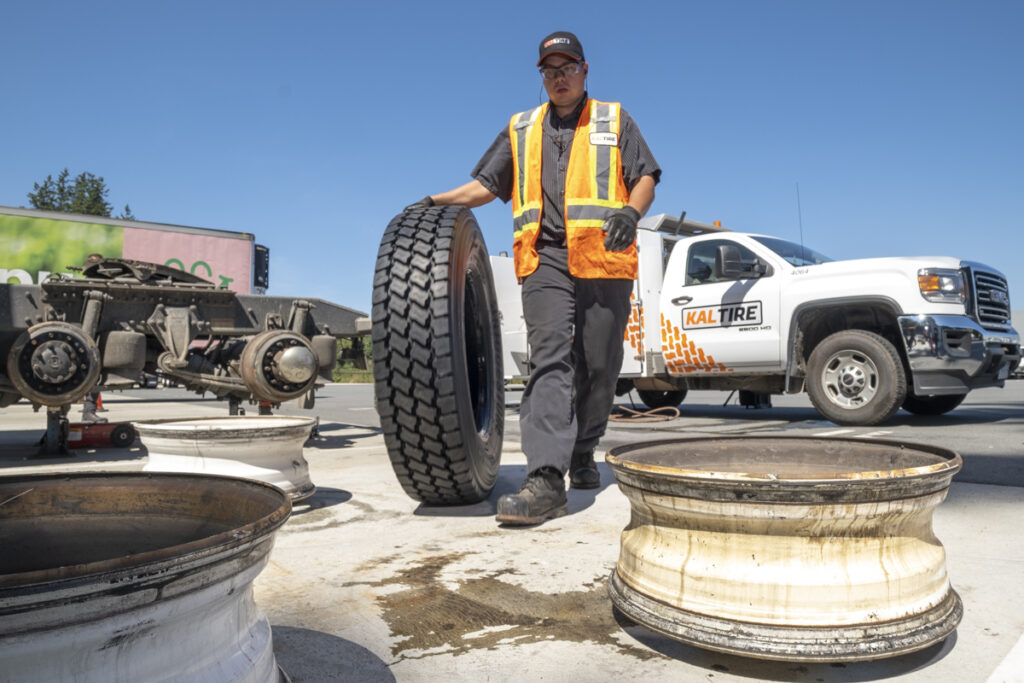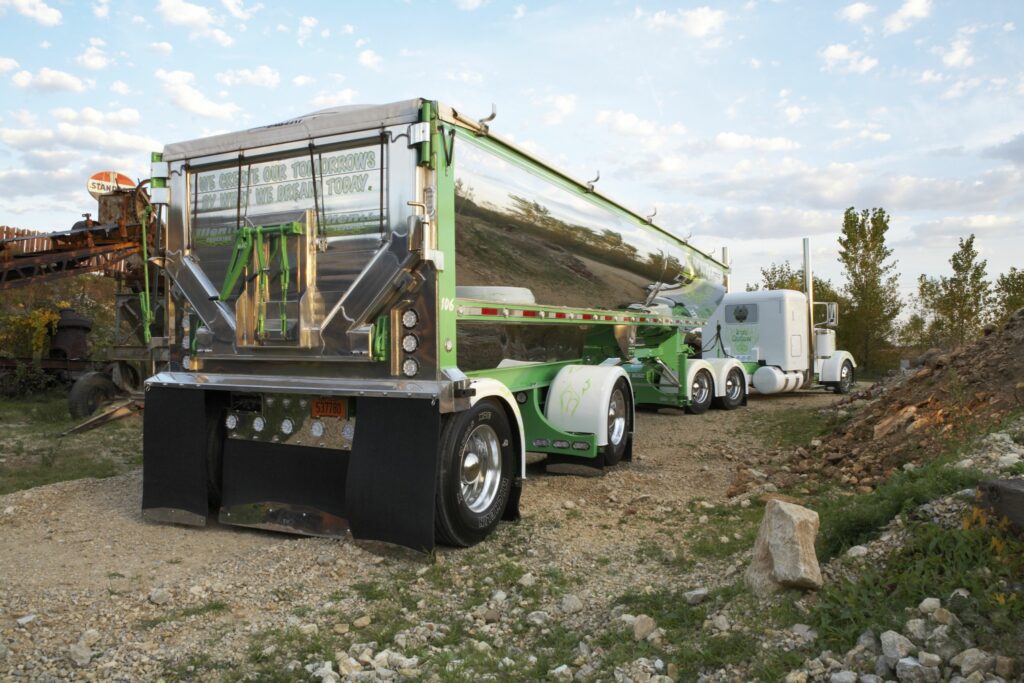Understand compromise when spec’ing fuel-efficient tires
Surging diesel prices have fleets seeking every opportunity to shave fuel consumption, and tires are an obvious place to look for improvements. Tire rolling resistance accounts for 33-35% of every gallon of fuel consumed at speeds of 35-55 mph (56-88 km/h), according to data from Michelin, with tires at the drive and trailer positions each accounting for 42% of that, and the steer tires 16%.
In a perfect world, fleets would be able to equip their trucks and trailers with tires that deliver the best in fuel economy, traction and wear mileage. But the reality is, prioritizing any one of those three attributes will require some compromise in one or both of the others.
“Tires designed for fuel efficiency don’t always fit the design we want to provide winter traction,” says Colin Rafferty, senior corporate account manager with Kal Tire. But while he suggests winter traction be a priority for those operating in Canada’s harsh winters – especially over hilly terrain – he acknowledges some tires designed to provide excellent traction will still achieve better fuel economy than others.
“There are certainly a lot of different options that are SmartWay-approved and have low rolling resistance, but still offer some of those other requirements fleets would need for sufficient winter traction,” he says.

Some traits found in low rolling resistance tires are apparent to the eye, such as shallower treads, with rib rather than lug or block designs, points out Matt Schnedler, senior product manager, Bridgestone Americas Tire Operations, U.S. and Canada. However, he adds the eye test only goes so far, as 55-65% of a tire’s rolling resistance is influenced by the casing.
Customers seeking the lowest rolling resistance tires are likely going to have to accept some compromise, and it’s important they understand exactly what those implications will be.
“Fuel economy, tread life and durability are all important elements in the design of a tire,” explains Schnedler. “As these factors are intertwined; improvements in one area typically affect the others. An easy way to reduce rolling resistance – and therefore improve fuel economy – is to reduce tread depth. However, reducing tread depth also reduces the overall tread life of the tire.”
Jim Garrett, product category manager with Michelin North America, tells customers to think of fuel efficiency, traction and wear mileage as a triangle. “As you move toward one, you lose some in one, the other, or both,” he explains. “Compromise is real and affects just about every decision we make.”
The easiest way for a tire manufacturer to improve rolling resistance is to change the tread rubber compound so it experiences lower energy loss as it compresses and springs back through the contact patch, Garrett explains. But, “These rubbers do not grip the road as well and tend to wear quickly. This is the way a lot of low rolling resistance tires are designed. Anyone can take an existing tire design and put in a more fuel-efficient tread rubber. This type of tire will have the full effects of the compromise.”
The challenge for tire manufacturers is to improve fuel economy while minimizing compromise in other areas.
“Over the years we have found ways to break some of the compromises associated with fuel-saving tires,” Garrett says. “One example is the use of silica in the tread compound.”
Fleets or owner-operators need to understand how severe any compromise will be and decide if it’s a trade worth making.
“In today’s environment, the fuel savings can be 10 times more than the trade-off in miles,” says Michelin’s Garrett.
With so many competing claims of fuel economy superiority in the market, and few ways to predict the impact reduced rolling resistance will have on traction or tread life in a specific duty cycle, Rafferty said fleets should conduct tests within their own operations before changing suppliers. Tire dealers can offer anecdotal insights from similar fleets, but Rafferty says every operation is unique and test should really be conducted internally.

“With telematics, there’s a lot of good information available to determine, how is the fuel efficiency and does it change significantly enough to warrant a change in tires?” he says. “Each fleet is so unique in terms of where they run, it has to come out of a trial within that fleet.”
“Fleets need to identify which property is most important for their purpose, so they can maximize that particular attribute,” adds Schnedler. “This choice is very important, as tires today are very application-specific. Choosing the wrong tire may result in poor performance in all three areas.”
Steady improvements in the design of standard low profile 22.5-inch (295/75R22.5) tires have some fleets second guessing the benefits of converting to wide-base single tires for fuel economy.
“Advances in technology have made the standard almost as fuel-efficient as the wide-base single,” Schnedler says. “Thus, adding payload has become the main driver in the value proposition for the wide-base tire. Other reasons for the switch back to duals is on-road availability in the case of tire failures, treadwear, and more choices with standard profile tires.”
Kal Tire’s Rafferty agrees the uptake of wide-base singles in Canada has been slower than in the U.S. for those reasons and more. He adds challenges regarding retreadability to the list.
“We see close to 50% of those ultra-wide-base tires submitted for retreading end up getting rejected,” he says, citing belt separations caused by running wavy asphalt highways compared to the firmer, smoother concrete Interstate highways seen in the U.S. “Ultra-wide-base tires are an expensive way to go if you don’t get the benefit of retreading.”
Canadian fleets that are committed to wide-base singles tend to spec’ them for the weight savings, he adds. Fleets that gross out before cubing out, such as bulk carriers, can save up to 200 lb. an axle and convert that directly into extra payload.
Michelin pioneered the design of wide-base single tires some 20 years ago, when the pursuit of low rolling resistance was just beginning. Garrett acknowledges “the large gap between duals and next-generation wide-base single tires has narrowed.”
However, he adds the main attributes inherent in wide-base singles remain. “Half the number of sidewalls deflecting, saving energy and weight,” he explains, noting the new X One Line Energy D2 single tire is the company’s lowest rolling resistance drive tire ever produced. “The main idea is that instead of deflecting four sidewalls [as with dual tires] through the contact patch, the next-generation wide-base singles only deflect two sidewalls. This reduces the loss of energy. It also reduces weight.”
Rafferty warns that wide-base singles tend to be designed for rolling resistance, and not traction, with closed shoulders and non-aggressive tread patterns that are needed for Canadian winters. They may be well suited for a fleet in Southern Ontario that runs north-south, but less so for a fleet in B.C. that regularly runs the Rockies. And he notes there are long stretches of Canadian highway where it’s difficult to source a wide-base single tire in the event of a blowout.
Once you’ve chosen a tire that best serves your needs for traction, fuel economy, and tread life, you’ll need to take good care of that asset to maximize your investment. It begins with maintaining recommended tire pressures, Rafferty notes, but vehicle alignment should also be considered.
“The number one thing to do is always going to be to maintain pressures. You’ll get better fuel economy, it will help your tires last longer and maintain the integrity of the casing for retreading,” he explains. “Misalignment, for obvious reasons, is going to burn more fuel because you’re not running straight down the road. You’re going to burn more fuel and experience tire wear issues.”
Have your say
This is a moderated forum. Comments will no longer be published unless they are accompanied by a first and last name and a verifiable email address. (Today's Trucking will not publish or share the email address.) Profane language and content deemed to be libelous, racist, or threatening in nature will not be published under any circumstances.
A lot of offshore tires use more fuel. Look at total cost and recaps for trailer usage. I think that a closed design is best for snow I see many people put recap trailer tires on drive spot in spring and move to trailer after 6 months to stretch out drive tires life.